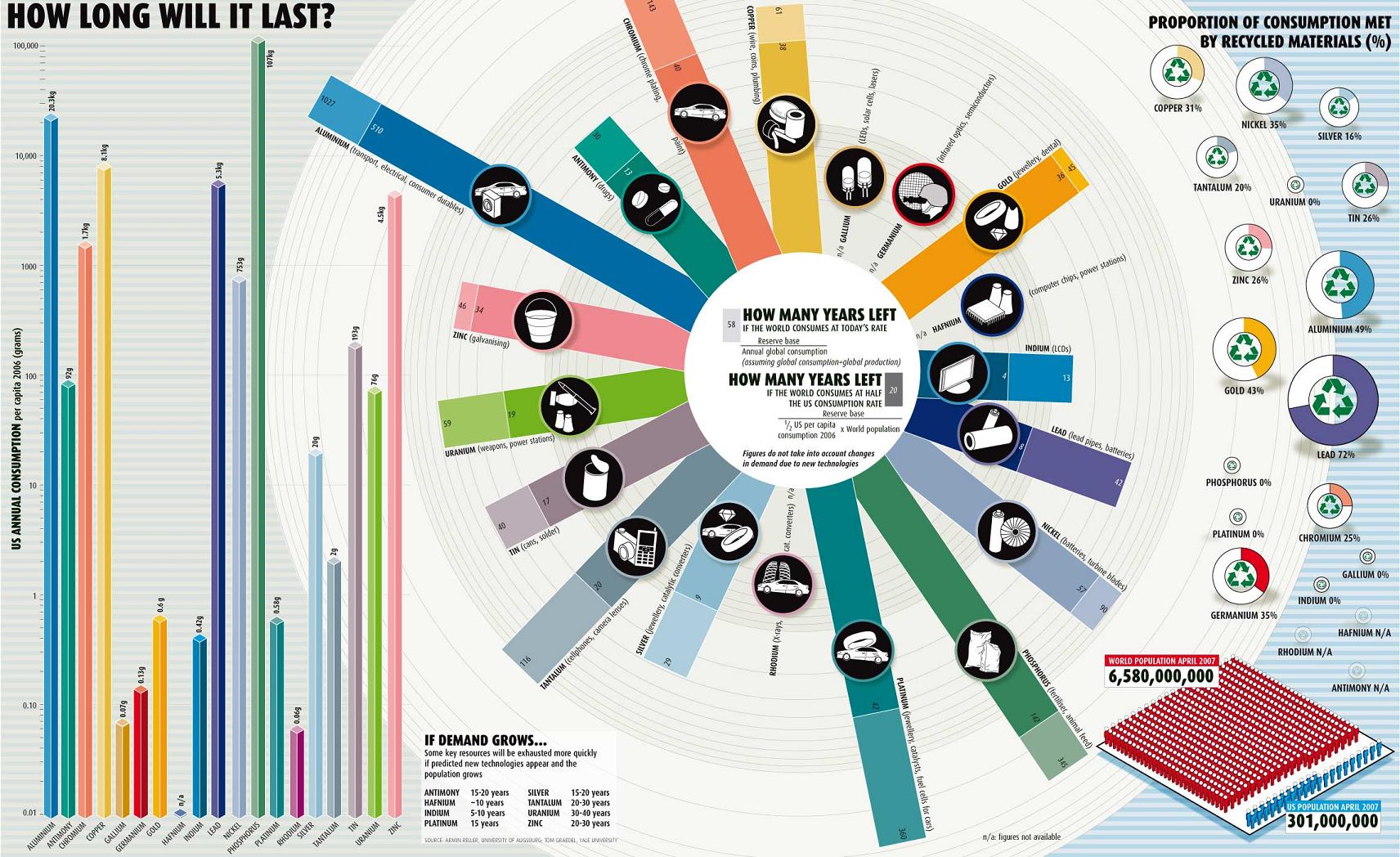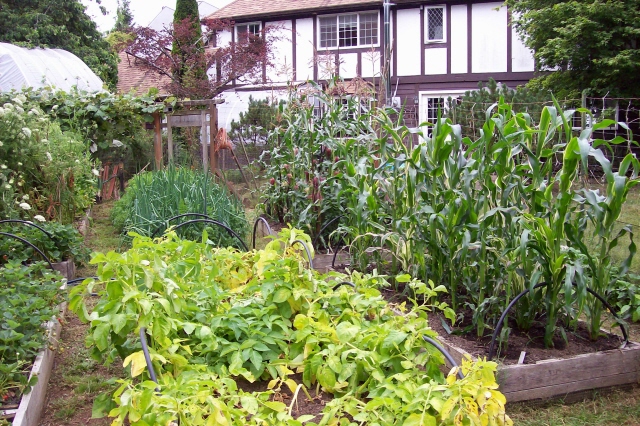Modern civilization is urban down to its rural roots, hates nature, ignores nature, depends on nature, destroys nature, yet expects nature to keep on giving. Now nature is striking back. The result is a slow-motion tragedy of catabolic collapse 1, like the oroboros tail-eating snake. To withstand the collapse, a revolution in food production will be critical. This essay is a contribution to that revolution.
My exploration of this subject will be based on three premises:
- Following the laws of energy and matter known to scientists as the Laws of Thermodynamics, the geological record shows that affordable access to the resources that underpin industrial economies is finite and rapidly declining on earth due to ever more mining by those very industrial economies.
- Human society is subject to the laws of nature we see working in natural ecosystems. Ecosystem science teaches that any species, including ours, that overshoots the carrying capacity of its resource base eventually goes into collapse. Hence, the science of ecosystems is the proper disciplinary framework to design ecologically healthy, durable farms to weather the collapse. That is, we must conceive farms as agroecosystems.
- Our world is characterized by connections, and functions in wholes. Any attempt to understand it by looking only at parts will produce limited results, and ultimately, failure. Three centuries of scientific research looking at only relations of a few parts produced a body of knowledge whose technological consequences are reliable only under those laboratory conditions. A holistic approach to problems is essential to bring the process of advancement of knowledge back into balance.
These premises are not widely understood, and are actually often denied or opposed by currently dominant beliefs. Modern society holds these deeply indoctrinated myths: ‘resources are infinite and material progress has no limits’; ‘man is in control of nature, not the reverse’; ‘the miracles of technology prove that reductionist/laboratory science is good enough to solve all our problems’. Therefore, before presenting my thoughts on an agroecological model, the following discussion will expand on the perspective of each premise in the hope of gaining a better basis for understanding what follows.
Premise #1 – Resource Scarcity
A first premise of this essay is that the industrial age and the fossil energy that fuels it is gradually ending. This assumption will be bucking a headwind, the apparently secular religion of industrial times, that these times and their associated technological miracles will go on forever. The religion persists for two reasons: it is partly due to ignorance of the conclusive evidence from the historical, geological record of accelerating resource depletion, carefully kept from most of humanity’s sources of information. Faith in industrial progress also endures partly due to willful ignorance, because the end of the three-century industrial bonanza is too insufferable for most people to contemplate.
Therefore, this essay will target that slowly increasing marginal population that is open to taking the premise seriously. In short, the geological evidence from the extractive industry is that the easy oil (and all other raw materials essential to sustaining an industrial society) has been consumed. When we have to drill through a mile of seawater and another mile of bedrock in an extremely risky project in the Gulf of Mexico called Deep Water Horizon, which ended in a disaster that wiped out the fishing and tourist industries from Tallahassee to Houston, that should tell you that the age of easy oil is over.
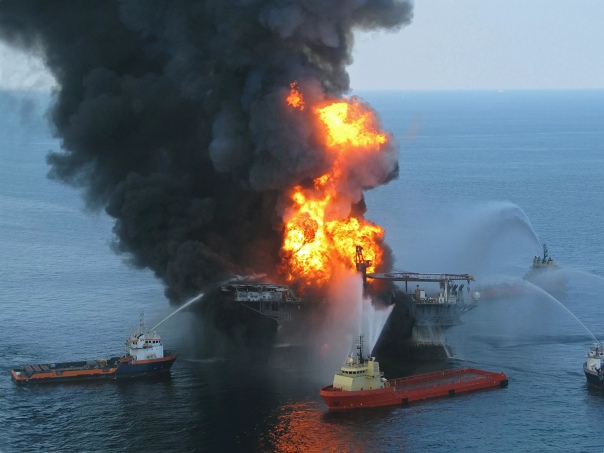
Gulf of Mexico, oil Platform Deepwater Horizon, April 20, 2010.
The pattern of raw materials extraction is always to harvest the low hanging fruit at any given time. In most cases, humanity is now harvesting the dregs, throwing ever more scarce energy at the problem to temporarily keep the flow of raw materials going that the industrial economy needs to survive. An extensive literatureii documents this ‘energy descent’ from cheap finite resources to their increasing scarcity that is now occurring. Moreover, the literature includes conclusive evidence that the attempted replacement of fossil energy at any significant scale by “renewables” will be too costly in fossil fuel itself as access to it declines. 2
Click image to enlarge
Consequently, this essay will offer a model of adaptation to living with increasing scarcity of fossil energy, a model of increasingly radical emancipation from external inputs and devotion to input self-sufficiency. And it will suggest a pathway from the luxury of the current energy-intensive distance economy to a decentralized, local one. It will focus on the challenges of adaptation of food production systems, one of the essentials of survival, to increasing resource scarcities. Viewed as a goal pursued incrementally, this historic paradigm shift will be more manageable. Rejected as impossible or insufferable, it likely will diminish chances of survival for multitudes of humanity.
Premise #2 – Subservience to Nature’s Laws
One way to convey the second premise might be that while man appears in control, nature bats last. It is easy to revel in the current bonanza of technological miracles and not see the undertow of consequent damage to the natural resource base on which our survival depends. We can see the laws of nature working out this way in the legacy of the ancient societies that were the cradle of Western Civilization. From an ecological perspective, the historical result of the advent of agriculture and the subsequent rise of urban civilizations in the ancient societies in Western Asia was progressive desertification, visible and continuing in the region today. Where today are the fabled cedars of Lebanon, which held the soil on the hilltops? Overshoot of its resource base, leading to erosion of its carrying capacity, has been a major factor in the rise and fall of civilizations ever since. As an ancient philosopher observed, ‘where man walks, deserts dog his heels’.
The science of ecosystems is replete with demonstrations that the survival of all species, including the modern human primate, is dependent on holding consumption of resources within the carrying capacity of its resource base. Ecology teaches that the wholes called ecosystems consist of interacting clusters of species whose populations are regulated in large part by the fact that each species is food for others. Thus, the capacity of the resource base of each species to ensure its survival varies as a result of a complex interdependency of many elements of the whole. When one species (ours, let’s say) overshoots the carrying capacity of its resource base, it can throw the whole food web into violent oscillation and even collapse. Ecology has demonstrated many examples of the oscillation, collapse and even extinction of species populations locked in a food web of interdependency. To give a simplified example, the tundra supply, the arctic hare population that feeds on it and the arctic fox population that feeds on the hare all experience complex changes and severe oscillation over time that are the result of interdependency in an arctic environment low in species diversity (and the resilience that diversity affords).
Farming in a future increasingly less dependent on fossil energy and its related external inputs must therefore rely more on internal inputs provided by a deep understanding of ecosystem processes and the complex interactions of the many parts of the wholes that farmers will have to manage primarily as agroecosystems, not just production systems. The size of the human population and perhaps its ultimate survival will hinge on such a redesign of the food system.
This challenge is daunting. Today, few farmers, including organic farmers, study ecosystem science, nor is it the basis of programs in agricultural schools. Farmers in the organic farming movement have developed many practices that will be useful. But lacking exposure to the study of how natural ecosystems work as complex wholes, few have undertaken the design of whole agroecosystems. This essay will offer examples and initial steps as food for thought along these lines.
Premise #3- A Holistic World
It is easy to see that our world is characterized by connections, and functions in wholes. But to claim that the pursuit of knowledge must acknowledge this reality challenges the dominant way scientific research has been done since the 17th century. It challenges and exposes the limitations of the reduction of inquiry to studying the interaction of two or three variables - known as the reductive method - when in the real world whole clusters of elements interact and are often interdependent, with very different consequences. It challenges us to find ways to understand how these real-world webs function and change over time. Holistic methods of inquiry have shown that only by studying a problem behavior over time in its relevant systemic context can we hope to explain those nonlinear behaviors generated by the interaction of elements in the whole. Known to complexity science as emergent properties, they are all too common in our world, as the time graphs included below reveal.
Despite three centuries of scientific advancement of knowledge, we have only a limited understanding of the workings of living systems, from earth science down to the science of organisms like ourselves. Why is that? Decades ago, in The Structure of Scientific Revolutions, Thomas Kuhn described a progression in scientific inquiry where anomalies accumulate that the dominant paradigm or way of doing science cannot explain, and this eventually provokes a revolution. The revolution in scientific inquiry that is now challenging reductionist laboratory science goes by various names – system dynamics, complexity science, holism, chaos theory or simply systems thinking. The prototypical systems science is systems ecology depicted in premise #2, not only because of its methods, but also because it brings all other fields of inquiry under its umbrella. Thus, the need for a holistic perspective discussed here and the need for an ecological perspective (premise #2) are clearly related, and must work together to address the present state of ecological scarcity.
Examples of the necessary marriage of the two perspectives have appeared to nourish the revolution that Kuhn described. Using the methods of system dynamics to study a planetary system that is both social and biophysical, the Limits to Growth world model 3, which originated fifty years ago, generated these dynamics (how things change over time):
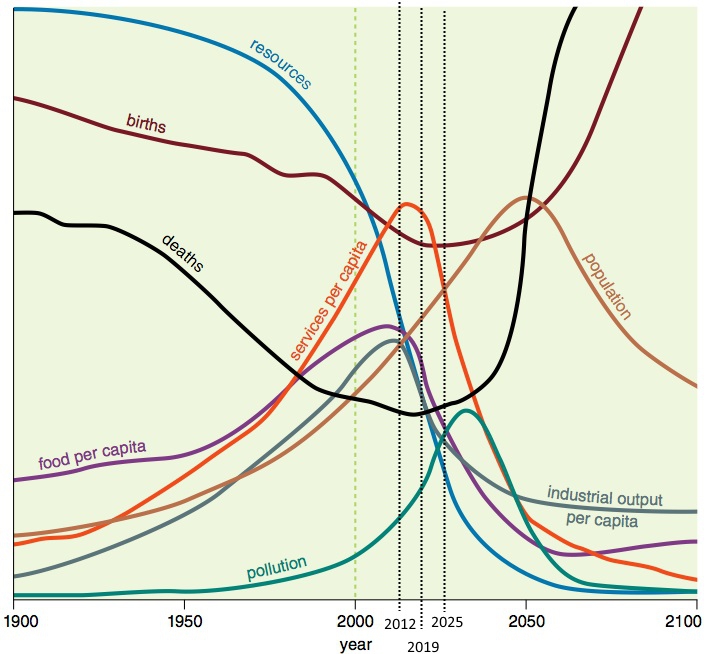
Updates since then have shown that the model tracks the historical record to date regarding at least the shape of change:
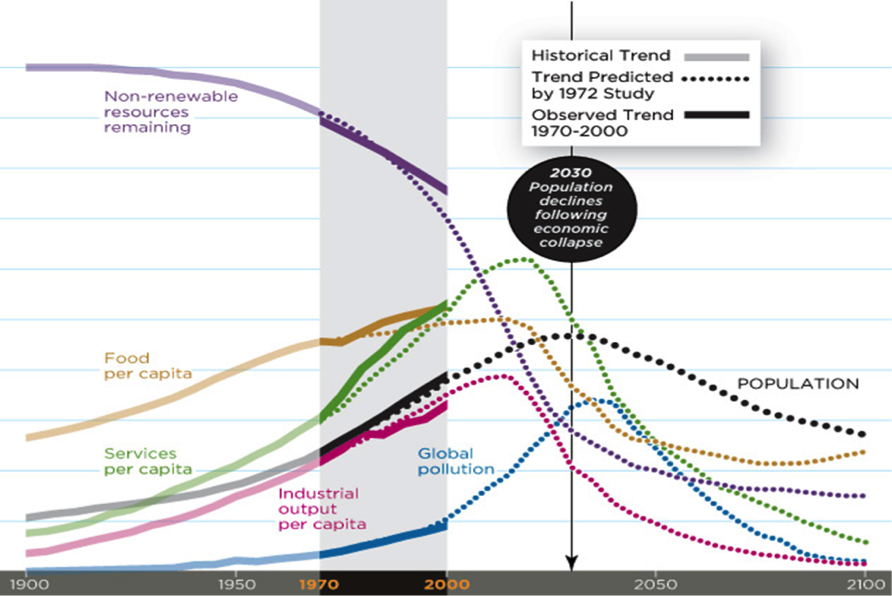
In another example, in 1980 William Catton was one of the first to combine the perspectives of social and ecological science in his book, Overshoot: The Ecological Basis of Revolutionary Change 4, in which he said that the advent of fossil fuels had led to an unsustainable “phantom carrying capacity” in natural resource use. He called it phantom carrying capacity because it permitted temporary human population levels and in the rich societies, per capita resource consumption levels, that took the planetary ecological load far above real carrying capacity. Eroding carrying capacity due to overshoot would cause collapse, as would become clear once fossil fuels became scarce.
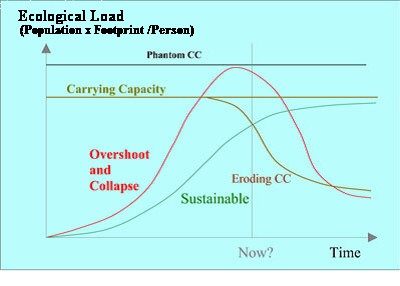
The systems revolution is not meant to displace reductionist science or to deny its utility, but rather to acknowledge its limitations and go beyond them. By studying problems in a real-world context that requires understanding of many disciplines, it challenges the compartmentalization of inquiry. An academic acquaintance once described his ivy league university as a gaggle of warring fiefdoms connected only by parking lots. Inquiry into the complexity that typifies our world must become transdisciplinary.
The investigation of complexity has revealed the limitations of even a systems approach. Although it can produce insights about how things work in holistic context, and can sometimes predict the rough shape of change, it can never completely crack the nut of complexity as a given way the world works, so it cannot deliver the predictive accuracy of laboratory science. Nor has any other existing method of studying problems in their real-world context, where cause and effect often feed back to generate unexpected consequences that are not accurately predictable.
However, the study of complexity has shown that, while revealing the limitations of science, systems thinking can improve with practice because, like proficiency as a musician, it is somewhat of an art. Peter Senge 5 advises The Five Whys (just keep asking why) to get to root causes in complex situations. Alan Savory 6 has created an accessible tool to gain practice in holistic thinking and decision making. Two of us organic farmers have adapted Savory’s work for farm planning in the US Northeast 7. Such tools all train us to see problems in terms of their relevant larger systemic context.
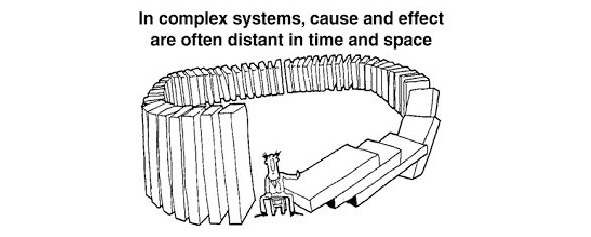
To conclude this introductory discussion of premises, it appears that failure to take them seriously has led to a world whose ecosystems are so depleted and ecologically damaged as to threaten the collapse of our species as well as many others. In the words of William Ophuls 8, who has been tracking the process for fifty years:
We have been spoiled by ecological abundance, a false abundance based on cornucopian premises, into thinking that the wants of the individual are more important than the needs of the human and natural communities.
Because of strong resistance to accepting these premises, the revolutionary overhaul of all industrial societies will likely not be due to policy changes except at the very small scale, local level, and will be forced on society by the train of events. This essay will present some possibilities for adaptation in farming systems designed in ways that acknowledge and work within the premises I have outlined.
Agroecosystem design: natural ecosystems as models
Our planet consists of ecosystems, of which humanity and its works are a subservient subset. Ecosystems are clusters of elements, some animate, others not, that interact and become interdependent in complex ways, and are dynamic, changing over time. Long before the advent of our species, life self-organized into these complexes, whose interaction achieved two important synergies:
- They often maximized the carrying capacity of the system – the maximum biomass that the land could support.
- They also achieved a degree of self-regulation via food webs – a matrix of predator-prey and cooperative relationships – that enhanced the sustainability of the whole.
“To put it in thermodynamic terms, nature’s tendency is to internalize costs and thereby wring a maximum of life from a minimum of energy, trapping it and using it over and over within a given ecosystem to produce biological wealth before it decays into dispersed, random heat as the Second Law ordains.” – William Ophuls – The Tragedy of Industrial Civilization. 2023.
Historically, Nature’s ‘farming systems’ have a much better track record for durability than ours. This is why, in the words of two pioneering agroecologists 9, “farming in Nature’s image” needs to become our design standard. While no replacement for serious study of ecosystem science, this section will outline ecosystem processes and principles sufficiently to give direction to thinking about farming systems as agroecosystems. Thinking about sustainable design to respect carrying capacity has effectively focused the attention of ecological scientists on maximizing the long-term health of four fundamental ecosystem processes in agroecosystems:
Mineral cycle
Mother Nature does not buy fertilizer. Minerals tend to cycle through the plants, animals and microbes in the food web where each living thing becomes food for others, and back to the soil where they become nutrients for plants and subsequently for the rest of the food web all over again. The implication for farming is to design the agroecosystem so that each organism is best managed to carry out its function in the mineral cycle.
Water cycle
Mother Nature does not seed the clouds or dance for rain. Driven ultimately by solar energy, water cycles from earth to clouds and back, and is captured in various ways for use in the ecosystem. Good agroecosystem design will enhance that capture in many ways, not least in the organisms in the food web themselves.
Energy flow
Mother Nature is off-grid, relies entirely on the sun and its derivative energies, like wind and wave. Solar energy enters the system through plants, thus called ‘primary producers’, and flows through the food web, but is ultimately lost as heat to outer space. Continued flow, including storage for later use, is a necessity of survival. Farm systems that maximize the primary producer population and its productivity will capture the most energy for re-use in the rest of the system, and thus maximize productivity in the whole. Species diversity will store energy for re-use.
Biological community dynamics
Mother Nature puts all the organisms to work together for the health of the whole. Nature is not just competition: ‘bloody in tooth and claw’. Cooperation is essential for survival, not only of individuals, but of the whole ecosystem. Species collaborate in symbiosis, enhancing health and productivity of each. They perform regulatory roles to keep population growth of other species in check. Farm design will include not just production species, but all species that can work toward the health of the whole, deliberately placed in collaborative roles. It will include a species diversity that fills all niches in the ecosystem that are relevant to agroecosystem health and durability. It will include species that perform important functions in the recycling of energy, water and minerals.
The ecosystem processes described above all exist on farms, and work either for or against each other, depending on how we manage them. The weakest one will be the limiting factor that determines the health of the whole agroecosystem. As in all living systems, improving the weakest link in a chain will do the most to improve the whole. This general rule, known as Liebig’s Law of the Minimum was first stated in the 19th century by agronomist Justus von Liebig who discovered that the uptake of the minerals in plant nutrition is inhibited by the least available one.
Agroecologists have shown that sustainability pertains only to whole farming systems. Hence, thinking only about practices must become part of a larger design and management approach that judges practices according to their ability to improve the ecosystem processes and therefore the whole system. If that sounds complicated it is because farming in Nature’s image takes much more knowledge than conventional agriculture.
However, a focus on these four ecosystem processes has led to the development of principles or attributes of sustainable agroecosystem design intended to maintain, or in many cases regenerate, the health of these ecosystem processes. Some of these principles and their implications are:
- Low external inputs - Input self-sufficiency.
- Low losses – Relatively closed water, nutrient and carbon cycles that avoid losses of valuable resources, leaks that eventually cause environmental damage.
- Stability – Resilience – Adaptive Capacity – These qualities of sustainability are all necessary, but since they exist somewhat in tension, one must attempt a balance among them. Stability is the quality that produces reliable results and minimizes risk, but in excess, stability can become rigidity. Hence, a certain flexibility is required for resilience, which is the ability to rebound from sudden change, weather events like a dry period in the farming season. Flexibility also includes adaptive capacity to respond to slower environmental changes, both man-made and natural, that have been a constant for millennia. These include invasive species, decimation of keystone species, weather disasters and climate change with long-term consequences and management policies that provoke ecological succession or even its reversal, all of which are disturbing the natural tendency toward a rough balance in the ecosystem. Reserves of material or energy, overlaps, redundancy, or other slack in a system provide that flexibility, but at the price of efficient use of resources.
- Knowledge intensity – Reliance on technologies that are powerful but derivative of a narrow, specialist knowledge base will give way to a broader, more demanding knowledge of farms as complex ecosystems of interdependent species, a knowledge that enables the creation of biodiversity to capture synergies, to biologically control pests with trap crops, for example.
- Management intensity – Farming for input self-sufficiency and limited leaks will require more labor devoted to management planning and monitoring to replace other resources or use them more efficiently to maximize sustainable yield: productivity/acre.
Food for thought: historical models of agricultural systems
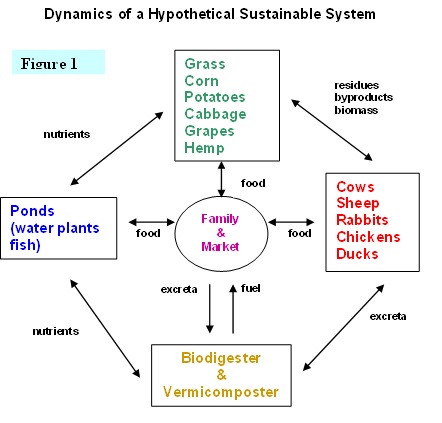
Some of the most durable and productive low input farming systems in history are designed around two concepts:
- Animals that can accelerate the growth and conversion of plants to fertilizer. Because they are highly multifunctional, ruminant mammals rank highest among these. Beyond their manure production function, they can consume fibrous perennials unusable for human food. These perennials can grow on hill land too rocky or too erodible for food cropping. Used as work animals, ruminants multiply the energy input from human labor many times. They provide a source of concentrated protein food that can be conserved and stockpiled for winter consumption. They provide hides and fiber for clothing as well. Cattle, sheep, goats, alpacas, llamas and bison are ruminants that we can most easily use in agricultural systems in our environment.
- Water management schemes that integrate streams, ponds, paddies, floodplains or wetlands. Examples are Aztec Chinampas 10, East Asian rice-fish-duck paddy systems 11 and flood plain management systems in colonial New England 12. Learning from models such as these, instead of draining wetlands, farmers could manage them for high production per acre, while retaining their function as wetlands that provide ecosystem services to the region.
Animal integration has emerged as a key to successful agroecosystem design. According to Albert Howard, regarded by many as the father of organic agriculture, Nature never farms without animals. A major revolution in animal integration was first documented in detail by the French farmer/scientist, André Voisin 13. High organic matter soils are central to achieving healthy water and mineral cycles, and soils in humid temperate regions are exceptional in their ability to store organic matter and accumulate it over a period of years. Voisin’s book Grass Productivity demonstrated over fifty years ago that pulsed grazing on perennial pasture is the fastest soil organic matter building tool that farmers have, at least in temperate climates.
Based on Voisin’s methods, so-called ‘rotational grazing’ methods have spread among farmers in the US organic farming movement, but few have grasped the holistic nature and importance of Voisin’s work – to make intensively managed grazing the driving core of a crop/livestock agroecosystem that is highly productive with minimal external inputs. A notable exception is the group of Cuban agroecologists who came to the rescue of Cuban agriculture in 1989 when it lost access to the imports that its essentially high-input agriculture required. Building on Voisin’s thesis, their research showed that a system with roughly 3 acres of intensively managed forage land will both sustain itself in fertility and provide a surplus of fertility via vermicomposted manure to sustain roughly 1 acre of cultivated crops (Figure 2).
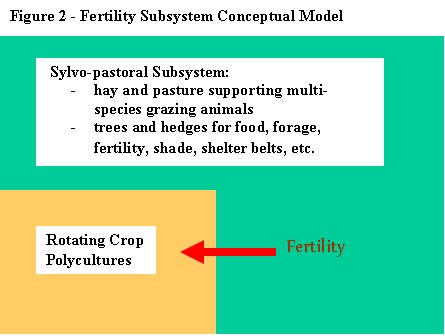
Like the Cubans, we operated Northland Sheep Dairy in upstate New York using insights from Voisin’s research. We designed our farm agroecosystem to adapt and improve on the natural grass-ruminant ecosystems that helped create the deep topsoils of Midwestern North America. In summary, the design focus is on three areas that are crucial to manage to maximize tight nutrient cycling. Key points of the farm nutrient cycle:
- Pasture management for a synergistic combination of productive, palatable perennial forages, kept in a vegetative state via high density, pulsed grazing throughout the growing season to maximize biomass production (according to planning principles developed by range ecologist Alan Savory) 14
- Manure storage in a deep litter bedding pack built under cover during the cold season to maximize nutrient retention and livestock health;
- Vermicomposting the bedding pack at a proper C/N (carbon/nitrogen) ratio during the warm season to maximize organic matter production, nutrient stabilization and retention, and spreading the compost during the warm season as well, to maximize efficient nutrient recycling to the soil.
This design is working well on our farm and confirms Voisin’s thesis: in a few years forage production tripled on land previously abused and worn out from industrial methods of agriculture, and soil organic matter is slowly improving. Like the Cuban system, it provided a gradually increasing surplus to fertilize cropland.

Conclusion: A Historical context
What are the chances that the agroecosystem approach will prevail?
It helps to put the age in which we live into historical context. The era of cheap energy permitted the mechanization and chemicalization of agriculture. In turn, this produced the largest increase in food production since the advent of agriculture. Synthetic nitrogen fertilizer, although very energy-intensive, alone was responsible for tripling the global population since its use became widespread. At least 80% of the energy in food production comes from oil. Mechanization has permitted economies of scale, and driven out family scale farming in many countries. Where the small farm has survived, in the organic movement for example, it has found a niche or a gentrified market. As one US Secretary of Agriculture warned, farmers have to “get big or get out”.
In the short to medium run therefore, designers of agroecosystems will contend with powerful forces in the political economy of agriculture that oppose any change from the dominance of the industrial model. Moreover, as the collapse of industrial society progresses, elites desperate to maintain social control are already resorting to policies that are ever more desperate and violent in every area of society, including the farm economy and the larger food system. This complex subject merits separate treatment, which I may undertake in a sequel to this essay.
However, as the oil age wanes, industrial agriculture, its associated large-scale farms and distance food economy will be less affordable and will fade away. This will provide the opportunity to return to small farms that serve a local economy. In the best of scenarios, energy and raw materials depletion will be slow, thus offering the time to transition gradually to such a relocalized agrarian society. On the other hand, unfavorable scenarios are likely. The demise of industrial agriculture could easily accelerate due to wars over depleting resources and a resultant collapse of global supply chains, which will hasten the collapse of the industrial system as a whole, not just agriculture. Moreover, as depletion progresses, net energy and net mineral per unit energy will decline ever more rapidly (see graph), and accelerate the increasing scarcity of essential resources.
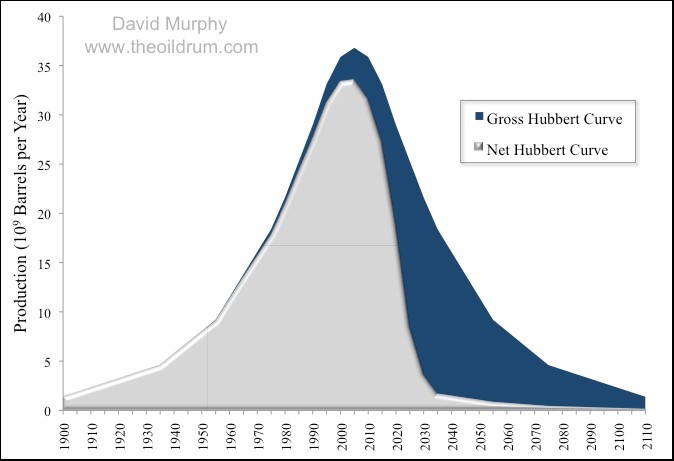
For longevity, natural ecosystems historically have far outperformed human managed ones in the modern age and every other age in the last 5000 years. All two dozen major civilizations since the advent of agriculture have crashed and burned from overshoot of carrying capacity and depletion of their resource base, or were overrun by peoples who still had resources to spare.
Whatever chance humanity might have of reversing this pattern will require a paradigm shift in the way we see ourselves and the world. A main thesis of this essay is that it will compel an acknowledgement of the premises on which I dwelt early in the essay. The shift must occur not just in our thinking, but in the way we start to live.
Despite lip service to learning from nature, only academic renegades and ecologist outliers like the Odum brothers, Holling, Wes Jackson, John Todd, Peter Rosset, Alan Savory, Miguel Altieri and Steven Gliessman learned enough ecosystem science to make serious contributions to improving agricultural sustainability to where food production might outlast the industrial, fossil fuel age. At least Altieri and Gliessman made the effort to write the first agroecology texts. These people are all outliers because almost no attempt has been made in academia to put agricultural science on a rigorous disciplinary basis, which is ecosystem science/systems ecology. Relying on these pioneers for inspiration and guidance, farmers will need to design their own agroecosystems to survive in the post-petroleum era. They should start now.
[1] A holistic view of catabolic collapse
Scenarios on the Downslope: Insights from Greer’s Ecotechnic Future
[2] My papers: Energy and Sustainability in Late Modern Society, The Industrial Economy is Ending Forever: an Energy Explanation for Agriculturists and Everyone
Books: The Long Descent: A User’s Guide to the End of the Industrial Age
Confronting Collapse: The Crisis of Energy and Money in a Post Peak Oil
The Crash Course: An Honest Approach to Facing the Future of Our Economy, Energy, and Environment
[3] Meadows et al. Limits to Growth. 2004
[4] Catton, William R. Overshoot: The Ecological Basis of Revolutionary Change. 1982.
[5] Senge, Peter. The Fifth Discipline: The Art & Practice of The Learning Organization.2006.
[6] Savory, Alan. 1999. Holistic Management: A New Framework for Decision Making.
[7] Henderson, Elizabeth and Karl North, Whole Farm Planning – Ecological Imperatives, Personal Values and Economics. Northeast Organic Farming Association. 2004
[8] The tragedy of Industrial Civilization: Envisioning a Political Future. 2023.
Ecology and the Politics of Scarcity. 1977.
[9] Piper, Jon and Judith Soule, Farming in Nature’s Image. 1992.
[10] http://www.chinampas.info/, http://en.wikipedia.org/wiki/Chinampa, Ancient Mayan Water Control Systems
[11] King, F. H.(Franklin Hiram). Farmers of Forty Centuries; Or, Permanent Agriculture in China, Korea, and Japan
[12] Donahue, Brian. 2004. The Great Meadow: Farmers and the Land in Colonial Concord
[13] Voisin, André. 1959. Grass Productivity. Philosophical Library, New York. Island Press Edition, 1988.
[14] Savory, Alan. Holistic Management. A Common Sense Revolution to Restore Our Environment. Third Edition. 2017
Author
Karl North has been a student, a farmer, a business owner, and a teacher. As a student, his strongest focus for over 50 years has been systems ecology and political economy (the power relations in social systems).



